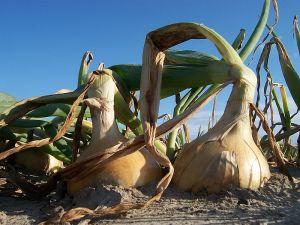|
|
Onions are one of Australia’s largest export vegetable crops. In order to remain competitive within export markets, and to increase domestic consumption, the onion industry must continue to improve product quality and seek new marketing opportunities based on product quality. Increasing consumer awareness of the health benefits that can result from eating vegetables represents an aspect of product quality that has received little attention to date but may provide a significant market advantage to industries which can prove the therapeutic value of their product. Such products are being described as functional foods (foods containing significant levels of biologically active components that impart health benefits beyond basic nutrition) and their therapeutic benefits may be an important selling point for consumers. The health benefits of eating onions and other related allium species are widely recognised, and have been attributed to two main groups of compounds in onions, the flavonoids and sulfur compounds. The objectives of this one year feasibility study were to assess the levels of sulfur compounds and flavonoids in Australian onions, and to compare these with levels in onions produced in other countries and in stored onions.
Findings : The two main groups of compounds in onions that have been associated with therapeutic properties are the flavonoids and sulfur compounds (cysteine sulfoxides). While the sulfur compounds represent a group of chemicals who’s main dietary source is the allium vegetables, the flavonoids (anthocyanins, flavonols, flavones, catechins, and flavonones and their glycosides) are phenolic compounds present in all crop species. Current interest in the contribution of bioactive components of food in disease prevention has lead to numerous studies of flavonoid concentrations and activities in foodstuffs while less attention has been given to the sulfur compounds. Australian onions appear to be a very rich source of the antioxidant flavonoid quercetin. Based on published epidemiological studies, consumption of moderate amounts of lightly sauted onions or raw onions in salads may reduce the risk of cancer and cardiovascular disease. The therapeutic benefits of onion consumption may be at least partially attributed to the concentration of quercetin in the bulbs, with sulfur compounds also likely to contribute to the health benefits derived from onion consumption. Vegetables, fruit and beverages are the main dietary sources of the flavonoids, and the high concentration of quercetin identified in Australian onions suggests that they would represent a significant percentage of flavonoid in the typical diet. Large variations in quercetin content in onions sampled from different locations at different times of the year may be due to climatic factors, principally light levels, influencing flavonoid accumulation. Evidence has also been presented that field curing of onions for 3-4 days resulted in accumulation of higher concentrations of quercetin. The detection in this study of quercetin concentrations in onions five to ten times higher than previous reports may also reflect the effects of high light exposure (including UV light) and field curing in Tasmania. Identification of effective strategies to maximise flavonoid accumulation would ensure that the natural advantages associated with the climate and varieties grown in southern Australia are fully realised. Acknowledgements : This research was funded by Horticulture Australia, the Department of Primary Industries – Victoria, and supported by Field Fresh Tasmania Pty Ltd. The Australian Government provides matched funding for all HALs R&D activities. |
||||||
|

